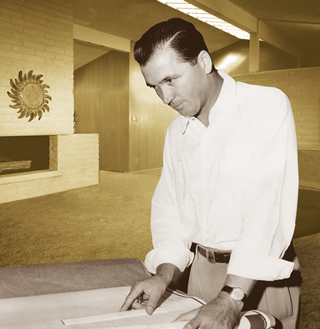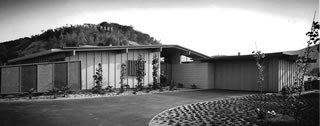Forgotten Giant
 |
|
|
By the time he'd hit age 37, the word was getting out—Ed Fickett was a miracle man. More than that, he'd become a brand name.
"Six years ago," the magazine 'House and Home' reported in 1953, in a nine-page article devoted to his career, "Ed Fickett was just another young man with a T-square, an agile pencil, and an urge to go places in architecture."
Now, the article continued, he was heading a ten-person office in Beverly Hills and grossing more than $100,000, "almost all of it from a resource that other architects had scratched off their lists as 'impossible' long ago." Tract homes.
"The market Fickett tapped had the hidden potential of a Los Angeles oil field," 'House and Home' enthused.
 |
 |
|
|
Then the magazine revealed how many homes Fickett had designed—18,000, many with high ceilings, open beams, open plans, and walls of glass.
Sure, in early subdivisions Fickett's homes were a "dolled-up, ranch-type 'hybrid'" of modern and traditional, the magazine said. But Fickett convinced some of his merchant builder clients to go all the way—or at least part of the way—into the future.
In Sherman Park, his latest subdivision at the time in Los Angeles' booming San Fernando Valley, Fickett was turning out the "first large-scale tract of all-out contemporary design in the Los Angeles area." Moreover, the homes were outselling the competition.
Advertisements throughout the 1950s show just how much builders and buyers appreciated Fickett homes, bragging of his authorship. 'By the famous architect Edward H. Fickett,' ads proclaimed. Even sales signs in front of the models were emblazoned with his name.
Fickett designed for many developers and in all price ranges—$8,400 for a Downey subdivision in 1950, $7,500 four years later for homes in Covina, $26,500 three years after that in Rollingwood Estates on the Palos Verdes peninsula. He was prized by developers for keeping costs down and sales up.
Meanwhile, the number of homes to his credit climbed. By 1955, the 'Los Angeles Times' reported, he'd designed 30,000 homes. By 1960, the 'Times' upped that to 40,000 to 50,000, the 10,000 fudge factor suggesting that not even Fickett himself knew the true number. And he continued designing tract homes into the 1980s, at least.
Throughout the Los Angeles area, Ficketts can be found. He designed homes up north as well, 1,000 or more in South San Francisco. Down south, he did the clubhouse and many homes at La Costa Resort, north of San Diego.




